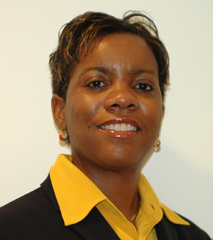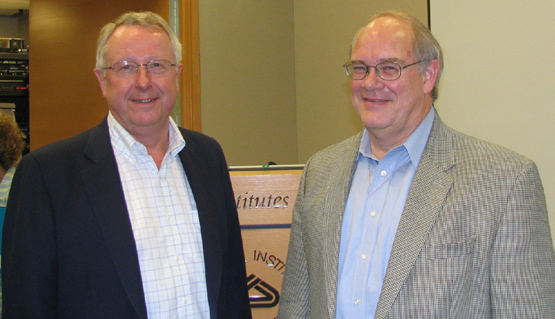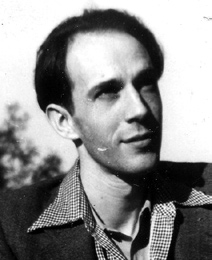cover
previous story
next story
|
 |
 |
Burton Named CIT Division Director
|
 |
| Photo: Melba McGlamary |
Adriane Burton has been named new director
of CIT’s Division of Computer System Services.
“We have every confidence that she will continue the tradition
of leadership excellence that she has established throughout her federal career,” said Dr. Jack Jones, acting director of the Center for Information Technology.
Burton is a 2006 graduate of the HHS Senior Executive Service Candidate Development Program,
where she led several enterprise architecture
initiatives at the Office of Management and Budget. For the past 8 months, she has served as acting deputy CIO (chief information officer) for the Indian Health Service. During her tenure there, she managed IHS’s award-winning
Electronic Health Record, IT infrastructure,
information security, IT strategic planning,
capital planning and investment control and the National Data Warehouse.
Burton joined CIT in 2001 as deputy director of the Division of Network Systems and Telecommunications,
where she advanced NIH’s network, security, video, telecommunications and cabling programs. She began her federal career in 1988 at the Internal Revenue Service, where she served as a computer systems programmer for major tax-processing systems and transformed IRS’s network communication systems. In 1996, she transferred to the Department of Justice where she served as branch chief of the Network Service Center and consolidated DOJ’s 14 networks into one.
“I am fortunate to take the helm from steady leadership and I am confident that we have excellent opportunities to further our shared mission across the NIH,” said Burton of her new post. “My immediate goals are to: increase shared scientific computing power; implement additional IT services to enhance collaboration;
expand IT co-location services especially for disaster recovery purposes for critical NIH services; and introduce server virtualization to optimize shared computing opportunities.” — Michele Mulholland France |
Tosten Appointed EO at Fogarty
|
|
Timothy J. Tosten is the newly appointed executive officer
at the Fogarty International Center. He will oversee all administrative operations, including financial management,
information technology, general administration,
ethics and procurement. In addition, he will manage
the Lawton Chiles International House as well as the other international services FIC provides to NIH, including the notice for foreign travel system and the official government passport process.
Tosten comes to FIC from the National Institute of Mental Health, where he was associate director for administration in the Division
of Intramural Research Programs. In addition, he was co-chair of the NIH intramural administrative officers group.
He came to NIH as a presidential management intern in 1993 for the Office of Research Services. He spent 12 years at ORS, where he worked in varying areas, including managing the child care programs and food services contracts and the NIH travel contract. He also initiated the first-ever NIH-wide sign language
interpreting services contract. He oversaw construction of the East Child Care Center and the Bldg. 35 cafeteria, renovation of Bldg. 10’s B1 cafeteria and expansion of the child care center on Executive Blvd.
He is currently a member of the NIH administrative training committee, where he chairs the newly formed Administrative Fellows Program. Tosten holds a B.S. degree in political science from the University of Maryland-Baltimore County, and a master of public administration degree from the University of Baltimore.
|
Barr To Direct NIA Office
|
|
Dr. Robin Barr has been named director of the Office of Extramural Activities (OEA) at NIA. He will oversee the institute’s Scientific Review Office, National Advisory Council on Aging and Grants and Contracts Management
Office. Most recently he served as deputy director
of OEA and as NIA training officer since 1994, following
his work as program administrator for cognitive functioning and aging in NIA’s Behavioral and Social Research Program.
Over the years, Barr has been influential in NIH policy development, including changes in policy on career awards and development of the Pathway to Independence
Award for new investigators. He currently is working with a number of foundations to develop and sustain joint funding in areas of medical research training on aging and has helped establish two partnership initiatives targeting different stages of clinician-scientist training. A native of Scotland, Barr received his undergraduate and doctoral degrees in psychology from Oxford University in England and completed postdoctoral work at the University of Pennsylvania before joining the faculty of Ball State University in Indiana.
|
Ellwein Retires from NEI, Returns to Discuss International Eye Research
By Arthur Stone
|
 |
Dr. Leon Ellwein (l) joins NEI director Dr. Paul Sieving after
a seminar on NEI international activities. |
After officially retiring at the end of March as associate director for applications of vision research at NEI, Dr. Leon Ellwein returned as a special volunteer and gave the first vision brown bag seminar on the topic “NEI International
Activities.” He worked for NEI from 1991 to 2007.
NEI director Dr. Paul Sieving introduced Ellwein,
thanked him for his many years of productive
service to NEI and the vision community
and detailed the importance of his work in furthering awareness of the “international context of vision needs.” Ellwein had a number of major successes in facilitating research collaborations and visual impairment studies in numerous countries.
Sieving emphasized two achievements, both in 2005: the signing of the agreement between the United States and India to collaborate on expansion of vision research and Ellwein’s receipt of the International Golden Award from the Chinese Ophthalmological Society for facilitating academic exchanges between U.S. and Chinese vision researchers and for making major contributions to eye disease epidemiology
and prevention of blindness in China.
Ellwein discussed the global disease burden, as described in The World Health Report 2003, produced
by the World Health Organization. NEI has collaborated with WHO on the global burden
of eye disease since 1979 and Ellwein began his involvement in 1993. In the report, eye disorders
are ranked ninth in global disease burden,
after diseases such as HIV/AIDS, malaria and birth-related health conditions. However, Ellwein explained that if refractive errors (such as nearsightedness, farsightedness, astigmatism
and presbyopia, or aging eye) are included, eye disorders would rank fourth.
He described NEI’s ongoing collaborations with WHO and participating countries to help them build capacity to deliver eye care services to those in need. This involves assessment of the types and prevalence of visual impairment, the establishment of programs to reduce health care disparities and the delivery of eye-care services
in rural and urban settings. In addition to India and China, Ellwein also has worked closely
with researchers, nonprofit organizations and government officials in Mali, Nepal, Peru, Chile, South Africa, Malaysia and Brazil.
Beginning with a clinical trial comparing two types of cataract surgery in India from 1993 to 1996, NEI in collaboration with WHO has contributed
more than $7 million for trials since 1979. Nearly $2 million more will be added to the total for the period 2007 to 2011.
However, Ellwein emphasized that the collaborators
in these countries have done most of the work. “The high quality and timeliness of their field work, their openness to sharing data and their commitment to international communication
has made all the difference,” he said. “The studies are theirs, not ours. We simply made them possible with our technical assistance and financial support.”
For the future, Ellwein sees collaborative research agreements being negotiated with other
countries such as China. “They are interested, and have several institutions highly qualified to do the work,” he said.
Dr. Mary Frances Cotch, chief of NEI’s Epidemiology
Branch, has assumed responsibility for continuing Ellwein’s international vision research facilitation efforts. Ellwein will continue
to serve as a special volunteer for the next 2-3 years.
|
Baird, Pioneer AIDS Nurse Researcher, Mourned
By Jenny Haliski
|
|
Barbara Fabian Baird, a Clinical Center nurse who was among the first to treat patients with HIV/AIDS, died Aug. 7 at age 69 after hospitalization for a brief illness.
She supported and conducted groundbreaking research that eventually led to the identification and treatment of HIV/AIDS. At a time when nurse researchers were uncommon, Baird cared for terminally ill patients, collected and stored biologic specimens, gathered and processed data, coauthored scientific papers and traveled around the country teaching other nurses how to care for AIDS patients. She was a pioneer in developing the role of study coordinator and case manager.
Originally from Charleroi, Pa., Baird later settled
in the Washington area to raise her family. She graduated from George Mason University with a bachelor of science in nursing in 1979 and earned a master of arts in communication from the University of Oklahoma in 1994. She came to NIH in March 1981 after hearing from a patient how impressed he was with the care and research conducted at the CC. Baird started
as a staff nurse on OP11 East, the unit for patients with immune disorders and infectious diseases.
In NIH’s oral history project, “In Their Own Words: NIH Researchers Recall the Early Days of AIDS,” Baird described the challenges of treating patients with unexplained immune dysfunction starting in the winter of 1981, including helping physicians develop infectious disease guidelines and managing the “overwhelming”
fear of some staff without stigmatizing
or isolating patients any more than they already were.
According to Baird, she “just fell into” her work with HIV/AIDS, saying it “offered an opportunity
at a particular time. I was right there and I wanted to take advantage of the opportunity to learn about a new disease.”
She described encountering suspicion and stigma for her vocation, “like I wore a big letter
‘A’.” She remembered the response when she described her work with AIDS research to a neighbor who welcomed her after a move. “I thought she was going to kick me out of the neighborhood. She said, ‘I’m surprised you even tell anybody about it.’ About the same time, or maybe shortly before that, my dentist and my doctor wrote on my chart, ‘Works with AIDS patients.’”
Despite her precautions, Baird experienced several
needle sticks, including one from the first AIDS patient at NIH. “I was used as the index case to show that hepatitis is more infectious than AIDS,” Baird said in 1993, noting that despite a subclinical hepatitis case and elevated liver enzymes, her HIV status remained negative.
“None of those needle sticks would happen
today because of the safety measures that have been instituted. All of the precautions I was using were adapted as the protocol for these patients with AIDS. I did not know that I was protecting myself against HIV because we did not know then that AIDS was caused by a virus.”
Bill Barrick, former head nurse of the HIV clinic,
recalls that Baird was a pioneer in the role of nurses as study coordinators and data managers
and showed how traditional nursing knowledge
and aptitude were essential to developing a professional role for nurses in clinical research.
Dr. Henry Masur, chief of the CC critical care medicine department, called Baird “a positive part of NIH history” who “took many young men under her wing in an era when few others would.”
Senora Mitchell, an administrative assistant in the HIV clinic on OP8, remembers
Baird as an avid tap dancer and a fantastic person who could always make others laugh. “She loved her patients and she gave them hugs and kisses when no one else wanted to touch them,” Mitchell said. Sandy Montgomery-Aker of NCI called Baird “the best friend that anyone could have. She was able to heal many troubled souls with her words and wonderful smile.”
She is survived by a brother, Stephen Fabian; three sons, Bruce, Bob and Bryan; and 12 grandchildren. |
Retired PHS Endotoxin Expert Milner Dies at 94
|
 |
| Dr. Kelsey Milner, circa 1943 |
Dr. Kelsey C. Milner, who retired from the Public Health Service at Rocky Mountain Laboratories in 1977, died of natural causes at age 94 on Aug. 22 at his home in Hamilton, Mont.
He was one of a key group of scientists in the 1960s and 1970s who helped bridge RML research from primarily
tick-related zoonoses to the detailed, modern
mechanisms of how pathogens survive immune responses.
“Kelsey worked at RML alongside scientists like Edgar Ribi and Jack Munoz, and he helped solidify RML’s reputation for excellence,” said Dr. Marshall Bloom, associate director at RML. “He was a great mentor and friend and a very sophisticated thinker and writer.”
Milner’s area of expertise was bacterial toxins (endotoxins) and how those secretions
killed immune cells. He frequently collaborated on research projects with Ribi, who ultimately opened a private lab in Hamilton, now owned by Glaxo-SmithKline.
In 1975, Milner was awarded the PHS Commendation Medal for outstanding research and leadership. His undergraduate degree was in English, and Milner took great pride in his manuscript writing and editing, often helping others prepare
their studies for publication.
The PHS sent Milner to RML in 1951, shortly after he earned his Ph.D. in microbiology
from Tulane University. Upon arriving, Milner was immediately detailed to Korea to study infectious diseases plaguing American troops. While working toward his Ph.D. in a hospital microbiology lab in New Orleans, he met Doris, who soon became his wife. They remained married for 65 years until his death.
The Milners reared their four children in western Montana, where they reveled in the outdoors and classical music whenever possible. A highlight for the family came in 1961, when Milner swapped homes and research roles for a year with a colleague at the Karolinska Institute in Sweden—with both families making the 1-year transition.
|
Benner Named OBSSR Communications
Specialist
|
|
Ann Benner has been named communications specialist for the NIH Office of Behavioral and Social Sciences Research. In this newly created position, she will be responsible for developing a strategic plan to best communicate the cutting-edge research and discoveries in the behavioral and social sciences.
“There is a pressing need to inform various audiences about the discoveries in basic and applied behavioral and social sciences that can greatly improve the nation’s health and quality of life,” said Dr. David Abrams, OBSSR director. “Ann’s public relations experience from both the public and private sectors makes her well-qualified to spearhead our communications
initiatives and serve as the OBSSR liaison to the NIH Office of Legislative Policy and Analysis.”
Benner was most recently a communications specialist
in NCI’s Office of Communications and Education, where she developed and implemented plans for communicating and disseminating clinical trial results. Prior to that, she was in NCI’s press office, where she worked with reporters and NCI scientists, responding to media inquiries, arranging interviews and developing communication strategies.
Before joining NCI in 2004, Benner was a media specialist at several public relations firms in New York, including Chandler Chicco Agency, Ogilvy Public Relations and Weber Shandwick, where she developed and managed strategic communication plans for pharmaceutical and biotech clients such as Amgen, Pfizer Inc. and Deborah Heart & Lung Center. Benner began her communications career publicizing books and authors for major publishing houses in New York.
She holds a B.A. in sociology with a minor in women’s studies from Duke University, where she graduated Phi Beta Kappa and magna cum laude.
|
 back to top of page back to top of page
|